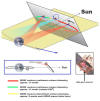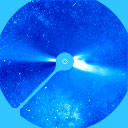|

The SOHO Spacecraft
|
-
LAUNCH DATE: 02-Dec-1995 08:08 UT
-
MISSION END: Approved until 2007
-
LAUNCH VEHICLE: Atlas II-AS (AC-121)
-
LAUNCH MASS: 1850 kg
-
MISSION PHASE: Operational
ORBIT:
SOHO is operated from a permanent vantage point 1.5 million kilometers
sunward of the Earth in a halo orbit around the first Lagrangian point.
ACHIEVEMENTS:
Discoveries from SOHO include:
-
Complex currents of gas flowing beneath the visible surface of the Sun.
Rapid changes in the pattern of magnetic fields. |

Artists impression of the SOHO spacecraft |
|
 |
SOHO has:
-
Made the largest and most detailed database of solar surface features.
Become the most prolific discoverer of comets in the history of astronomy,
although not designed for the purpose.
THE MISSION:
SOHO is a space-based Observatory is viewing and investigating the
Sun from
its deep core, through its outer atmosphere - the 'corona' - and the domain
of the solar wind, out to a distance ten times beyond the Earth's orbit.
|
About LASCO
 The
Large Angle and Spectrometric Coronagraph (LASCO) instrument is one of
11 instruments included on the joint NASA/ESA SOHO (Solar and Heliospheric
Observatory) spacecraft. SOHO was launched on 2 December 1995 at 08:08 UT
(0308 EST) from the Kennedy Space Center, Cape Canaveral, Florida. The
LASCO instrument is a set of three coronagraphs that image the solar corona from
1.1 to 32 solar radii. It is convenient to measure distances in terms of
solar radii. One solar radius is about 700,000 km, 420,000 miles or 16 arc
minutes. The
Large Angle and Spectrometric Coronagraph (LASCO) instrument is one of
11 instruments included on the joint NASA/ESA SOHO (Solar and Heliospheric
Observatory) spacecraft. SOHO was launched on 2 December 1995 at 08:08 UT
(0308 EST) from the Kennedy Space Center, Cape Canaveral, Florida. The
LASCO instrument is a set of three coronagraphs that image the solar corona from
1.1 to 32 solar radii. It is convenient to measure distances in terms of
solar radii. One solar radius is about 700,000 km, 420,000 miles or 16 arc
minutes.
A coronagraph is a telescope that is designed to block light coming
from the solar disk, in order to see the extremely faint emission from the
region around the sun, called the corona.
The essential questions of solar physics to be addressed by LASCO are:
-
How is the corona heated?
-
Where and how is the solar wind accelerated?
-
What causes coronal transients, and what role do they play in the
evolutionary development of large-scale coronal patterns?
LASCO was built by an international consortium of four institutions in four
different countries:
-
Naval Research Laboratory, Washington, DC
-
Max-Planck-Institute for Aeronomy, Lindau, Germany (see also LASCO C1 home
page, in German)
-
Department of Physics and Space Research, University of Birmingham,
Birmingham, England
-
Laboratoire d'Astronomie Spatiale, Marseille, France
The LASCO electronics box also provides services for an additional
experiment called the Extreme Ultraviolet Imaging Telescope (EIT).
|


 The
Large Angle and Spectrometric Coronagraph (LASCO) instrument is one of
11 instruments included on the joint NASA/ESA SOHO (Solar and Heliospheric
Observatory) spacecraft. SOHO was launched on 2 December 1995 at 08:08 UT
(0308 EST) from the Kennedy Space Center, Cape Canaveral, Florida. The
LASCO instrument is a set of three coronagraphs that image the solar corona from
1.1 to 32 solar radii. It is convenient to measure distances in terms of
solar radii. One solar radius is about 700,000 km, 420,000 miles or 16 arc
minutes.
The
Large Angle and Spectrometric Coronagraph (LASCO) instrument is one of
11 instruments included on the joint NASA/ESA SOHO (Solar and Heliospheric
Observatory) spacecraft. SOHO was launched on 2 December 1995 at 08:08 UT
(0308 EST) from the Kennedy Space Center, Cape Canaveral, Florida. The
LASCO instrument is a set of three coronagraphs that image the solar corona from
1.1 to 32 solar radii. It is convenient to measure distances in terms of
solar radii. One solar radius is about 700,000 km, 420,000 miles or 16 arc
minutes.